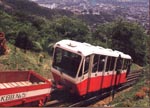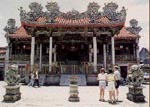|
Historical Attractions
Penang Hill
 The hills of Penang--Western Hill, Tiger Hill, Strawberry Hill, and
others--have long been popular refuges from the heat of the low-lying city.
As the funicular railway proceeds along its half-hour climb of the hill, a
broad panoramic view of Georgetown slowly unfolds. The view from Flagstaff
Hill, at the top of the line, is a lovely way to watch night descend over
the island. The train leaves the station at Air Itam at 6.30am and at every
half an hour. Train fare Adults: RM3, Children: RM1.50. The hills of Penang--Western Hill, Tiger Hill, Strawberry Hill, and
others--have long been popular refuges from the heat of the low-lying city.
As the funicular railway proceeds along its half-hour climb of the hill, a
broad panoramic view of Georgetown slowly unfolds. The view from Flagstaff
Hill, at the top of the line, is a lovely way to watch night descend over
the island. The train leaves the station at Air Itam at 6.30am and at every
half an hour. Train fare Adults: RM3, Children: RM1.50.
For those who enjoy a vigorous walk or fear a funicular ride, there is a
very good walking track up the hill. It takes about four hours and should
not be undertaken frivolously. The jungle trail begins at the moongate at
Waterfall Road, about 300m from the entrance to the Botanical Gardens.
[More]
Beach Street
 Beach Street is the commercial hub of the Island. Many famous banks around the island are located here, including the Hong Kong and Shanghai Bank (HSBC), Standard Chartered Bank, etc. The buildings have been standing since the colonial days, thus possesing heritage values. [More]
Beach Street is the commercial hub of the Island. Many famous banks around the island are located here, including the Hong Kong and Shanghai Bank (HSBC), Standard Chartered Bank, etc. The buildings have been standing since the colonial days, thus possesing heritage values. [More]
Fort Cornwallis
 This fort was built on the site of Francis Light's historic landing in 1786.
Originally a wooden stockade, it was replaced by a concrete structure built
by convict labor, in 1804. Today, an open-air amphitheatre, a history
gallery, and a handicraft and souvenir centre occupies the interior. Fort
Cornwallis also houses a famous Dutch cannon that in some way or another has
been associated with virtually every shift in political alliances on the
Peninsula since the early 17th century. The cannon arrived on the Peninsula
in 1606 as a present from the Dutch to the Sultan of Johor. Only a few years
later the Dutch cannon was taken by the Achenese in a raid on Johor's
capital. At the beginning of the nineteenth century the cannon was sent to
by the Achenese to Kuala Selangor in hopes of establishing an alliance with
the Bugis. The cannon's last move, from Kuala Selangor to Penang, followed
the British bombardment on Kuala Selangor in 1871. This fort was built on the site of Francis Light's historic landing in 1786.
Originally a wooden stockade, it was replaced by a concrete structure built
by convict labor, in 1804. Today, an open-air amphitheatre, a history
gallery, and a handicraft and souvenir centre occupies the interior. Fort
Cornwallis also houses a famous Dutch cannon that in some way or another has
been associated with virtually every shift in political alliances on the
Peninsula since the early 17th century. The cannon arrived on the Peninsula
in 1606 as a present from the Dutch to the Sultan of Johor. Only a few years
later the Dutch cannon was taken by the Achenese in a raid on Johor's
capital. At the beginning of the nineteenth century the cannon was sent to
by the Achenese to Kuala Selangor in hopes of establishing an alliance with
the Bugis. The cannon's last move, from Kuala Selangor to Penang, followed
the British bombardment on Kuala Selangor in 1871.
Opening Hours: 8.30am -
7.00pm
Admission: RM 1 per person.
Cheong Fatt Tze Mansion
Landmark grade 1 restoration of an 1880 mansion of a rags-to-riches
Mandarin, The paradigm Chinese courtyard house, this architectural legacy is
a masterpiece of exceptional quality of design & craftsmanship. Named the
most excellent project by Unesco Heritage Conservation Awards 2000. The
mansion is now a 16-room bed and breakfast.
Khoo Kongsi
The wave of Chinese immigration to Penang during the nineteenth century gave
rise to the formation of clan formations, or kongsi, which served as
surrogate kinship and professional associations for immigrants who had left
behind family and friends. A multitude of kongsi arose in Penang, and each
organization constructed a hall to serve as the locus of its community.
 The Khoo Kongsi is the most famous example of these halls, having been
designed with such magnificence that it was said to rival the palace of
China's emperor. Whether by misfortune or because such a resemblance was
viewed as an offence, the original Khoo Kongsi burnt to the ground almost as
soon as it was completed. The present structure was built as a scaled down
version of that original, though it is an extraordinarily impressive
structure nonetheless. The building features a magnificent hall embellished
with intricate carvings and richly ornamented beams of the finest wood, each
bearing the mark of master craftsmen from China. Opening Hours: 9.00am -
5.00pm (Monday to Friday), 9.00am 1.00pm (Saturdays) Permission to enter
must be obtained from the Kongsi office. The Khoo Kongsi is the most famous example of these halls, having been
designed with such magnificence that it was said to rival the palace of
China's emperor. Whether by misfortune or because such a resemblance was
viewed as an offence, the original Khoo Kongsi burnt to the ground almost as
soon as it was completed. The present structure was built as a scaled down
version of that original, though it is an extraordinarily impressive
structure nonetheless. The building features a magnificent hall embellished
with intricate carvings and richly ornamented beams of the finest wood, each
bearing the mark of master craftsmen from China. Opening Hours: 9.00am -
5.00pm (Monday to Friday), 9.00am 1.00pm (Saturdays) Permission to enter
must be obtained from the Kongsi office.
|